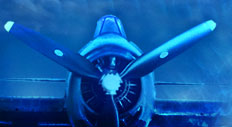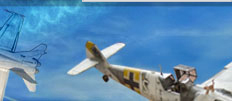|
Erich Hartmann, the most famous ace in history of aerial combat, had a total of 352 confirmed kills.
One of the best known surviving Luftwaffe aces, he was never shot down. During the latter half of WWII,
his planes were adorned with a “black tulip” design around
the spinner, and were also used by novice pilots for extra protection, as most Russian pilots
would not stay to fight him. He flew our Erich Hartmann Me Bf 109 G-6
in the Eastern Front (Hungarian theater) with the famous “black tulip” markings.
Scott Speicher's F/A-18 was the first aircraft shot down during the early hours of Gulf War I.
For many years, his whereabouts was unknown. His plane, along with his Escape and Evade sign,
and flight suit were found near the wreckage in the Iraqi desert. There was no evidence of his
death or survival. There has been some speculation that the initials MSS found in an Iraqi
prison may have been written by Scott Speicher, but it is not conclusive. Despite a massive
search effort by U.S. intelligence agencies, no proof of life or death has been found. However,
on August 2, 2009, the U.S. Department Of Defense reported that Scott Speicher's remains were
found in the Iraqi desert, close to the crash site. Scott Speicher died during the crash and
was never captured. His body was buried by Bedouins after the crash.
Frantisek Perina, one of the most successful Czech fighter pilots in WWII, shot down 15
German aircrafts. He himself was shot down and seriously injured in France. Initially
Frantisek flew under the French, and later served with RAF Czech Squadron 312. After WWII
he fled to U.K. and later to the U.S. to escape communist persecution in Czechoslovakia.
Frantisek Perina returned to his homeland after the fall of communism in 1989.
He died as a Czech general in Prague on May 6 2006. Our
replica of Frantisek Perina's Spitfire.

|
Frantisek Fajtl, the most famous Czech pilot from WWII. Although not an ace, Frantisek Fajtl
is well known because of his leadership role in the war. Like many other Czech pilots, Frantisek fled his
homeland during WWII to fight Nazi occupation. He was a popular wing and squadron commander
under both the British and the Soviets. After the war, the communist persecuted him for fighting
along with the British. Condemned to a labor camp at Mirov for 18 months,
there he saw the same former SS officers he fought against. After his imprisonment, he worked
as a laborer and clerk. His war achievements were finally recognized after the fall of communism
in 1989. He was rehabilitated and given the rank of major general. Frantisek Fajtl died on
October 4, 2006 in Prague. Our replicas of Frantisek Fajtl's favorite Supermarine Spitfire Mk Vb, Supermarine Spitfire Mk Vb and
Lavochkin La-5.
[ more on Frantisek Fajtl ]
Werner Schroer, German ace with 114 confirmed kills, began as a ground crew with the German
air force. He completed his flight training in 1940 and was assigned to a squadron (I/JG 27)
involved in the Battle of Great Britain where he scored his first victory. He was later
assigned to North Africa under Erwin Rommel where he continued to accumulate his largest
number of kills. Werner Schroer survived WWII. He died in Munich on February 10 1985 at
the age of 67. Our replica of Werner Schroer's north Africa corp Messerschmitt with tropical
camouflage [Me Bf 109 E-7 trop],
fitted with tropical sand filter on the supercharger.
Hans Philipp, German ace with 206 confirmed kills. Toward the end of the war, Philipp was
appointed as Commodore of JG1. His most famous statement came from his defiant response to
Reichmarshall Goring's edict after the 8th AF raid on October 4, 1943:
Reichmarshall's Idict:
[excerpt from “Defending the Reich: The History of Jagdgeschwader 1 – Oesau” by Eric Mombeek].
|
| 1) |
There are no meteorological conditions which would prevent fighters from taking off and engaging
in combat.
|
|
| 2) |
Every fighter pilot taking off in a machine not showing any sign of combat or without
having recorded a victory will be prosecuted by a court-martial.
|
|
| 3) |
In the case of where a pilot uses up his ammunition, or if his weapons
are unusable, he should ram the enemy bomber.
|
|
Philipp's defiant response: “As far as I'm concerned, I categorically refuse to
allow myself to be held to such advice; I know what I have to do!”
Hans Philipp was shot down and killed in action on October 8, 1943.
Hans Philipp's Me Bf 109 F-4
|
|
Frantisek Dolezal, – WWII Czechoslovakian Ace: 10 confirmed kills.
He was the Wing Commander of the 2nd Czechoslovakian Wing under the RAF. Like many other Czech pilots,
he fled his homeland to avoid serving under Hilter during the Nazi occupation of Czechoslovakia.
He initially fled to France, later eventually serving under the British. He served in various pilot
and command role in 310th, 19th and the 2nd Wing under the RAF. Dolezal rose through the ranks quickly
and receive numerous awards for his bravery, and leadership skills. Among his peers, he was a well
respected leader. He was intelligent, humorous, and optimistic. Under his command, the 310th won
numerous football matches against British as well as dogfights against the Nazis. He kept a
portfolio of all the pilots who served under him, including information on their achievements and
their private life. Like many famous fighter aces who survived the war, he died in a peace time plane
accident. On Oct 4th, 1945 near Bucovice na Morave, during a training flight from Prague to Zlin his
plane, a Sibel Si-204, crashed. Frantisek Dolezal's
Supermarine Spitfire Mk Vb.
Winfried Schmidt, a German ace with 19 kills, who shot down the famous British ace
John “Doggie” Oliver, was severely injured during one of his missions. His injuries
prevented him from returning to duty. He was grounded until the end of the war.
Winfried Schmidt's Me Bf 109 E-4.
Heinz Bar, a German ace with 221 victories, was one of the few aces that flew the Me 262,
the first operational jet fighter. With 16 kills while piloting the Me 262, Bär was the top
jet ace of WWII. His record for jet aces still stands today, only matched by Capt.
Joseph McConnell in the Korean War. While achieving his 221 victories he himself was shot
down 18 times, surviving each crash and returning to duty. His luck finally ran out on
April 28 1957 when Heinz Bar died in a light plane accident in Braunschweig, Germany.
Heinz Bar's Me Bf 109 E-1
George W. Bush, President of the United States, was the first sitting president ever to
pilot a landing on an aircraft carrier (USS Abraham Lincoln). On May 2, 2003,
shortly after the beginning of Gulf War II, President Bush piloted a Navy S-3B Viking
marked with “Navy 1” and George W. Bush Commander-in-Chief below the cockpit
window. With the “Mission Accomplished” sign proudly displayed in the background,
President Bush confidently declared these famous words: “major combat operations in Iraq have ended”.
Gerhard Barkhorn, a German ace with 301 victories, became the “ace in one day” when he shot
down 6 enemy planes in a single day. The Soviet Air Force had a price on his head.
He was the best man at Erich Hartmann wedding.
Toward the end of the war, he piloted the latest Me 262 jet fighter, but was
unable to score any victory. On his last mission, his engine went out just
before reaching the enemy bomber formation. He was force to make an emergency
landing and was taken prisoner until the end of the war. After the war, he joined
the German Air Force (Bundesluftwaffe) in 1956 and retired in 1976 as a general.
He died from injuries sustained in an auto accident on January 6 1983.
Gerhard Barkhorn's Me Bf 109 G-16
|

















